How to Deploy Secure and Robust Wireless Connectivity for Smart Energy and Utilities
Contributed By DigiKey's North American Editors
2023-03-29
Wireless communications, including local networking and cloud connectivity, are an essential element in a range of smart energy and utility systems, including energy meters, critical infrastructure, green energy systems, electric vehicles, grid modernization, the smart grid, and smart cities. These applications often involve edge connectivity and require low latency, predictable and secure communication that can be supported using IEEE 802.15.4, Zigbee, Bluetooth, and other protocols. In some instances, they can benefit from a low-power, high throughput wireless protocol like the IEEE 802.11 g/n standard that provides high data rate network access within approximately 300 meters outdoors.
In addition, these wireless devices must meet the Federal Communications Commission (FCC) standards in the U.S., European Telecommunications Standards Institute (ETSI) requirements, and EN 300 328 and EN 62368-1 in Europe, Innovation, Science and Economic Development (ISED) in Canada, Ministry of Internal Affairs and Communications (MIC) in Japan, and others. Designing wireless connectivity and obtaining the needed certifications can be time-consuming, resulting in increased costs and extending time to market. Instead, designers can turn to pre-engineered and certified wireless communications modules and development platforms that can be easily integrated into smart energy and utility devices.
This article begins by reviewing several communications options and architectures for local networks and cloud connectivity, including wired and wireless networking options. Then it offers several wireless platforms from Digi, Silicon Labs, Laird Connectivity, Infineon, and STMicroelectronics for deployment of secure and robust wireless connectivity for smart energy and utilities, including development environments to speed the design process.
Big opportunities and challenges
Big challenges often accompany big opportunities. That's certainly the case when deploying smart energy and utilities in smart city infrastructure. First, there's the need to integrate existing and aging infrastructure effectively. Then, there's the need to deploy geographically dispersed and technologically heterogeneous networks that are efficient and robust. Finally, these networks will be expected to provide the flexibility to deal with future technology developments like the emergence of smart and connected vehicles.
For example, advanced automated traffic management systems can enhance safety, improve energy use, and reduce the environmental impact of cars, buses, and other vehicles. In this case, the centralized traffic management system is connected to the network through high-bandwidth fiber and wireless backhaul communications. Other system elements can include (Figure 1):
- Ethernet and cellular routers that support IP-enabled devices at the local level. In some cases, power over Ethernet (PoE) is added to extend network utility and control costs.
- Legacy equipment can be integrated through dedicated connections and serial ports.
- Local Wi-Fi and Bluetooth devices can monitor traffic densities and pedestrians with anonymized data. The resulting data can be analyzed locally and sent to the central traffic management system for decision-making and higher-level control functions.
- A combination of traffic cameras, sensors like radar or lidar, and other data sources are used by both local advanced solid state traffic controllers (ASTCs) and moved to the centralized management center for real-time optimization of traffic flows.
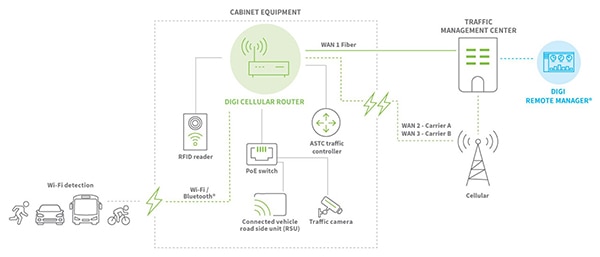 Figure 1: Automated traffic management in a smart city ranges from Wi-Fi detection of pedestrians and vehicles to traffic cameras and ASTC controllers and a centralized traffic management and control center. (Image source: Digi)
Figure 1: Automated traffic management in a smart city ranges from Wi-Fi detection of pedestrians and vehicles to traffic cameras and ASTC controllers and a centralized traffic management and control center. (Image source: Digi)
Overall energy efficiency, public safety, and reduced environmental impacts of urban roadways can be enhanced using:
- Detecting and minimizing congestion by modifying traffic flows and signal timing in near real-time with a combination of local and centralized controls.
- Adjusting signal timing to support efficient and on-schedule operation of buses and other forms of mass transit.
- First responders can be provided with optimized routing in real time to speed their arrival and minimize the overall impact on public safety.
Smart cities of the future
Today's smart cities are still mostly a work in progress. There are ample opportunities for improvements and advancements. Future smart cities will increasingly focus on integrated energy efficiency and improved quality of life. Electric vehicles (e-vehicles) and smart or autonomous vehicles will become the norm. They will be integrated into smart housing, smart charging infrastructure, smart delivery systems, and end-to-end transportation systems, including trains, light rail and buses, and electric robo taxis for 'last mile travel.'
Residents will use smartphones for a growing range of uses, including purchasing bus and rail tickets, speeding the process and further reducing the environmental impact of transportation. While transport will continue to be the major use of e-vehicles, it's not the only one.
Commercial vehicles like trucks, buses, cargo and delivery vans, and construction equipment account for about a quarter of the CO2 emissions in a city and about five percent of overall greenhouse gas (GHG) emissions, according to Infineon. Integrated charging infrastructure will need to be developed to accommodate the larger batteries in these commercial vehicles, in addition to charging passenger vehicles and e-bikes. The charging infrastructure will need to be interconnected and centrally controlled to maximize charging speed for the diverse types of vehicles and their use cases.
To support reduced environmental impacts, and improvements in quality of life and the efficient use of energy, complex real-time wireless networks will be needed that monitor the operation of dispersed renewable energy sources, microgrids, and energy storage, optimize energy utilization, manage water and wastewater use, and manage a wide range of transport and other systems. These real-time networks must be robust and have minimal latencies (Figure 2). To support smart city infrastructure, designers need tools that enable rapid development, deployment, and updating of complex communications networks and connected devices.
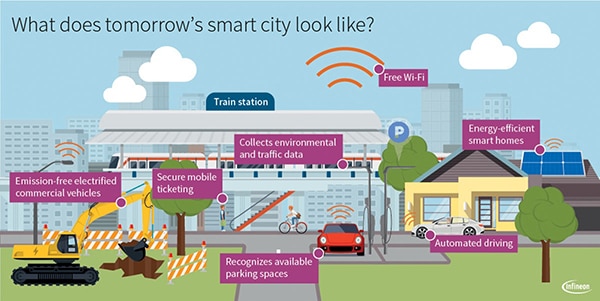 Figure 2: Smart city services will rely on robust, real-time wireless networks to connect diverse applications. (Image source: Infineon)
Figure 2: Smart city services will rely on robust, real-time wireless networks to connect diverse applications. (Image source: Infineon)
Secure networking with wireless modules
To quickly deploy secure networking, designers can turn to Digi's XBee RR Wireless Modules based on the EFR32MG21B020F1024IM32-BR wireless system on chip (SoC) from Silicon Labs that includes an 80 MHz ARM Cortex-M33 core and an integrated security subsystem. XBee modules leverage multiple wireless protocols and frequency bands like Zigbee, 802.15.4, and DigiMesh, as well as Bluetooth low energy (BLE) to support a wide range of network architectures. DigiMesh is a peer-to-peer mesh networking protocol that can reduce the complexity of using Zigbee for point-to-multipoint configurations. These modules support BLE and connection to another BLE device.
Smartphone connections can be used to configure and program the modules using the XBee mobile app. In addition, developers can use the XCTU configuration platform compatible with Windows, MacOS, and Linux. XCTU uses a graphical network view to simplify wireless network configuration and an API frame builder development tool for quickly building XBee API frames. Other modules' features and options include:
- Packaging options include 13 millimeters (mm) x 19 mm micro mount devices like the XBRR-24Z8UM, surface mount modules like the XBRR-24Z8PS-J, and through hole configurations like the XBRR-24Z8ST-J (Figure 3)
- The PRO version is FCC certified for use in North America, and the standard version meets ETSI standards for use in Europe
- Low-power and high-power module configurations
- Indoor/urban range up to 90 meters (m) (300 feet), depending on conditions
- Depending on conditions, the outdoor line-of-sight range up to 3200 m (2 miles)
- Integrated IoT security app simplifies integration of device security, device identity, and data privacy
 Figure 3: Packaging options for Digi XBee wireless modules include micro mount (left), surface mount (center), and through hole (right). (Image source: DigiKey)
Figure 3: Packaging options for Digi XBee wireless modules include micro mount (left), surface mount (center), and through hole (right). (Image source: DigiKey)
Smart gateways
The Sterling LWB+ modules from Laird Connectivity, like the 453-00084R are high-performance 2.4 GHz WLAN and Bluetooth combo modules designed for wireless IoT devices and smart gateways. They are based on the AIROC CYW43439 single-chip radio IC from Infineon and feature an operating temperature range of -40°C to +85°C making them suitable for a range of smart utility and smart city and energy applications. Sterling LWB+ modules have global certifications, including FCC, ISED, EU, MIC, and AS/NZS.
Sterling LWB+ modules include the medium access control (MAC), baseband, and radio, plus an independent high-speed UART for Bluetooth interfaces. Laird Connectivity and Infineon support the latest Android and Linux drivers. The integrated chip antenna is resistant to de-tuning and simplifies system design and manufacturing. The Sterling LWB+ series is a system in package (SIP) and is available with a trace pin, integrated chip antenna, or MHF4 connector. They also include WPA/WPA2/WPA3 encryption. These modules are available in four package styles to meet the needs of diverse system designs and application requirements (Figure 4).
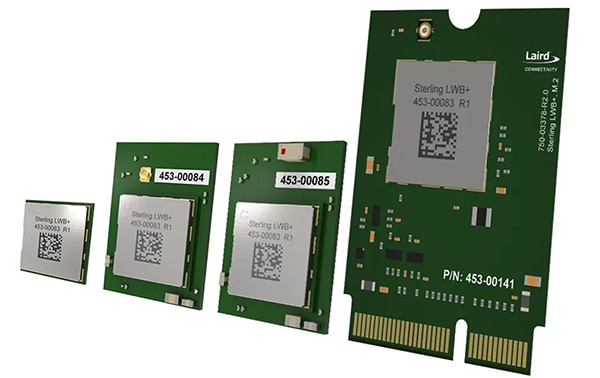 Figure 4: Basic Sterling LWB+ SIP (left), module with MHF connector (second from left), module with integrated antenna (third from left), and card edge connector (right). (Image source: Laird Connectivity)
Figure 4: Basic Sterling LWB+ SIP (left), module with MHF connector (second from left), module with integrated antenna (third from left), and card edge connector (right). (Image source: Laird Connectivity)
The Sterling-LWB+ includes a secure, high-performance, secure digital input and output (SDIO) that supports easy integration with any Linux or Android-based system. To speed development of wireless IoT devices and smart gateways, designers can turn to the 453-00084-K1 development kit, which includes the 453-00084R module with an integrated MHF connector (Figure 5).
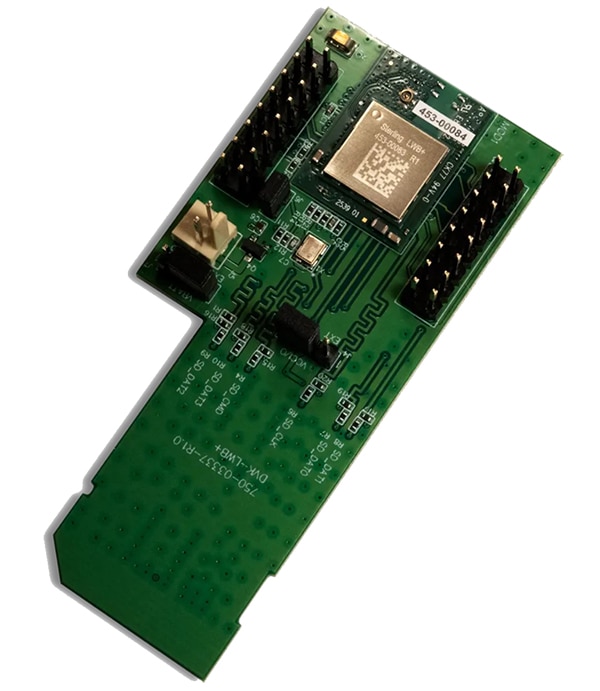 Figure 5: This dev board includes Laird's 453-00084R Sterling LWB+ module with an integrated MHF connector (Image source: Laird Connectivity)
Figure 5: This dev board includes Laird's 453-00084R Sterling LWB+ module with an integrated MHF connector (Image source: Laird Connectivity)
Wireless industrial-grade sensor nodes
Wireless sensor nodes are an important part of smart energy and utilities in smart cities. To help designers deal with the complexities of quickly designing, prototyping, and testing advanced wireless sensor nodes, STMicroelectronics offers the STEVAL-STWINKT1B SensorTile development kit and reference design. It includes an X-NUCLEO-SAFEA1A expansion board supporting IoT device authentication and secure data management, a BLUENRG-M2SA Bluetooth transceiver module, and an IMP23ABSUTR MEMS microphone. The MEMS microphone is designed to be used with the ultra-low-power onboard microcontroller for vibration analysis of 9 degrees of freedom (DoF) motion sensing data across a wide range of vibration frequencies from 35 Hz up to ultrasonic. It also includes an accelerometer, gyroscope, humidity sensor, magnetometer, and pressure and temperature sensors.
The SensorTile dev kit includes access to an array of software packages, firmware libraries, and cloud dashboard applications to speed the development of comprehensive end-to-end IoT sensor systems. An integrated module provides BLE connectivity, the RS484 transceiver supports wired connections, and the STEVAL-STWINWFV1 plugin expansion board offers Wi-Fi connectivity. The main board includes a STMod+ connector for adding small form factor daughter boards based on the STM32 family of microcontrollers. Finally, the development kit consists of a 480 mAh Li-polymer battery, a STLINK-V3MINI standalone debugging and programming probe, and a plastic box (Figure 6).
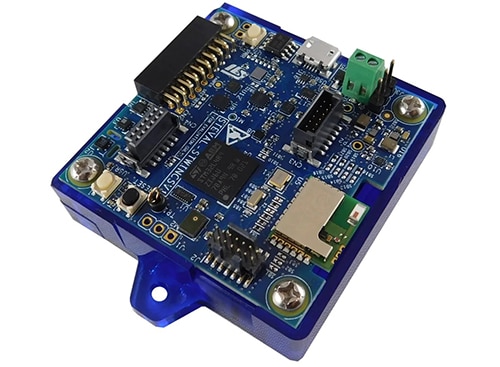 Figure 6: The STEVAL-STWINKT1B SensorTile dev kit and reference design include a comprehensive suite of environmental sensors and support for several connectivity options. (Image source: STMicroelectronics)
Figure 6: The STEVAL-STWINKT1B SensorTile dev kit and reference design include a comprehensive suite of environmental sensors and support for several connectivity options. (Image source: STMicroelectronics)
Summary
A range of wireless connectivity protocols is required to support the needs of smart energy and utility systems in smart cities. Those systems can enhance energy efficiency, improve public safety, support more efficient water and energy use, and reduce CO2 and GHG emissions. As shown, there are a variety of wireless modules and development environments for Wi-Fi, Zigbee, and Bluetooth low-energy wireless protocols that can provide the secure and robust connectivity needed for smart energy and utilities in smart city infrastructures.

Disclaimer: The opinions, beliefs, and viewpoints expressed by the various authors and/or forum participants on this website do not necessarily reflect the opinions, beliefs, and viewpoints of DigiKey or official policies of DigiKey.










